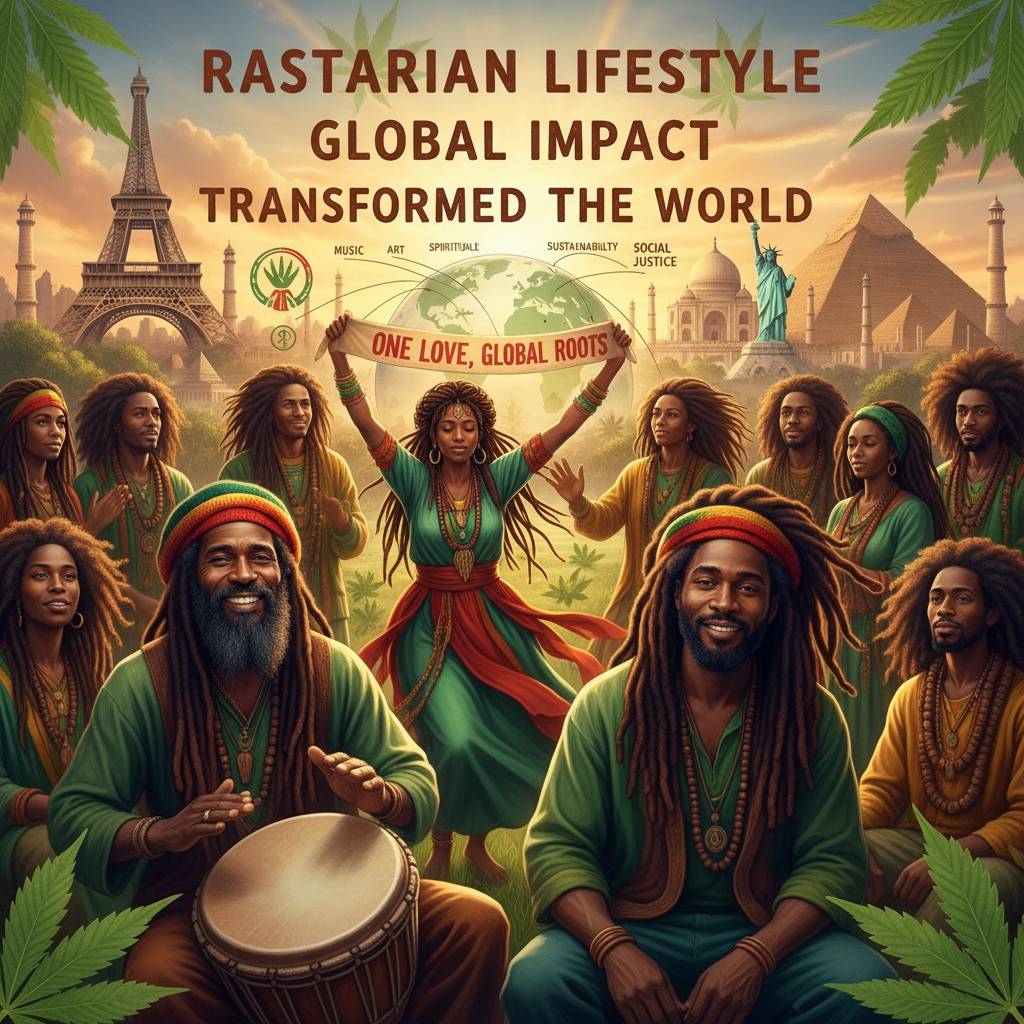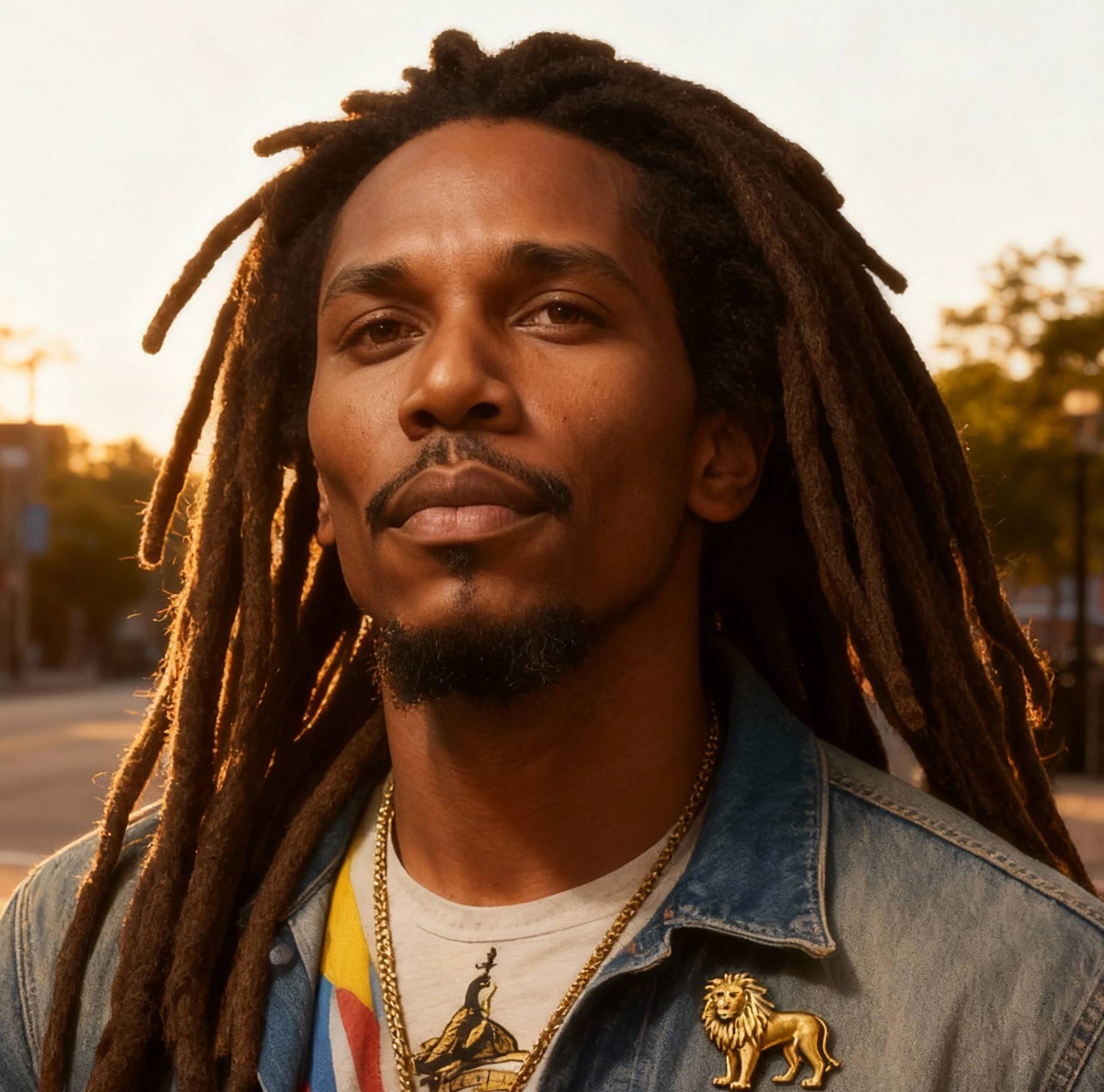Rastafarian Lifestyle Global Impact Transformed the World

How Culture, Food, and Music Transformed the World
From the Hills of Jamaica to the Hearts of Millions
Born from the soul of Jamaica in the 1930s, the Rastafarian Lifestyle Global Impact has transcended borders, languages, and faiths to become a symbol of resistance, spirituality, and peace. Rooted in Pan-African identity, Ital living, and Roots Reggae rhythms, this way of life has reshaped not only Jamaican identity but also the global understanding of liberation, community, and wellness.
The Rastafarian movement was never just about dreadlocks or reggae—it was about reclaiming identity, resisting oppression, and connecting with the divine within nature. Today, from the streets of London to the beaches of Brazil, Rasta culture continues to inspire new generations.
The Spiritual Foundations of the Rastafarian Lifestyle
Hail the King: The Rise of Ras Tafari
 At the heart of Rastafari is the reverence for Emperor Haile Selassie I of Ethiopia, believed by Rastas to be the living God (Jah) and a direct descendant of King Solomon. His 1930 coronation marked a turning point for Black identity worldwide. To the Rastaman, Selassie symbolized redemption, self-determination, and divine leadership.
At the heart of Rastafari is the reverence for Emperor Haile Selassie I of Ethiopia, believed by Rastas to be the living God (Jah) and a direct descendant of King Solomon. His 1930 coronation marked a turning point for Black identity worldwide. To the Rastaman, Selassie symbolized redemption, self-determination, and divine leadership.
The name Ras Tafari Makonnen became a rallying cry for Africans in the diaspora who sought freedom from colonial mindsets. The faith’s early pioneers—Leonard Howell, Joseph Hibbert, and Mortimo Planno—transformed spiritual resistance into a global consciousness movement.
Livity: The Heartbeat of Rasta Spiritual Practice
Rastafari isn’t a religion in the traditional sense—it’s a way of life, often called livity. Livity emphasizes harmony with nature, compassion for others, and alignment with Jah’s will. Practitioners view their bodies as temples, respecting the earth through plant-based diets, meditation, and natural living.
Naturalness: Avoiding chemical products, processed foods, and synthetic materials.
Peace and Love: Promoting unity and positive vibration through action and thought.
Connection to Nature: Seeing divinity in all creation, from herbs to the sea breeze.
This holistic outlook has influenced global spiritual movements—from the back-to-nature hippie wave of the 1960s to the rise of holistic wellness culture today.
Cultural Influence Dreadlocks, Symbols, and Social Movements
Crown of Identity: The Significance of Dreadlocks
To many, dreadlocks are just a hairstyle—but for Rastas, they symbolize spiritual strength, naturalness, and rebellion against Babylon (the system of oppression and materialism). The locks echo the Lion of Judah, representing courage and divine connection.
When icons like Bob Marley, Peter Tosh, and Burning Spear took the stage, dreadlocks became more than a statement—they became a movement. Across the globe, people adopted the look as a sign of pride and spiritual awakening.
Colors That Speak: Red, Gold, and Green
The Rasta colors, derived from the Ethiopian flag, carry deep meaning:
Red: The blood of martyrs and struggles of liberation.
Gold: The wealth of Africa and divine light.
Green: The land, fertility, and hope for renewal.
These hues have painted murals, inspired fashion lines, and appeared in countless protests calling for justice and unity. In global cities, the Rasta palette became synonymous with resistance and peace.
Global Social Movements and Rastafari Ideals
The ethos of “One Love” resonated deeply in a world divided by race, class, and ideology. In the 1970s and 1980s, Rasta ideology influenced:
Anti-apartheid movements in South Africa
Black Power and Civil Rights activists in the U.S.
Pan-African solidarity networks across the Caribbean and Africa
Even today, the spiritual activism of Rasta philosophy continues to shape conversations about identity, climate, and equality.
Ital Living The Global Rise of Rasta Food Philosophy
What Is Ital?
 Derived from the word vital, Ital food is central to Rastafarian living. It emphasizes purity, naturalness, and life energy. The diet excludes meat, dairy, and artificial additives. Instead, it celebrates fresh fruits, vegetables, grains, and herbs.
Derived from the word vital, Ital food is central to Rastafarian living. It emphasizes purity, naturalness, and life energy. The diet excludes meat, dairy, and artificial additives. Instead, it celebrates fresh fruits, vegetables, grains, and herbs.
An Ital meal nourishes the spirit as much as the body. Food is seen as medicine and prayer—prepared with mindfulness and shared in gratitude.
The Global Ital Revolution
Rastafarian Ital cuisine laid the foundation for many modern plant-based and vegan trends. Long before veganism became mainstream, Rastas were championing whole-food living.
In London, Ital cafés like Zionly Manna popularized Caribbean veganism.
In New York, Ital stew and curried chickpeas became staples of health-food markets.
In Ethiopia and Ghana, Ital restaurants blend traditional African cuisine with Caribbean spices.
Today, Ital’s message—“Eat clean, live clean, think clean”—is echoed in sustainability movements, detox culture, and eco-friendly dining worldwide.
Herbal Healing and Conscious Consumption
Rastafari herbalism has also contributed to the global natural medicine movement. Herbs like ginger, turmeric, soursop, and moringa are valued for their healing powers. The sacred herb—ganja—used ritually, symbolizes communion with Jah and deeper meditation.
Though often misunderstood, Rastafarians use ganja not for escape but for elevation—to quiet the mind and open spiritual awareness. This philosophy has influenced global wellness trends and even contributed to modern cannabis legalization conversations.
Roots Reggae — The Soundtrack of Spiritual Revolution
From Trenchtown to the World Stage
If Rastafarianism is the body, Roots Reggae is its heartbeat. Emerging from Kingston’s ghettos in the 1960s, reggae became the voice of the oppressed. Through hypnotic basslines and prophetic lyrics, Rasta musicians carried their message of liberation across the globe.
Artists like Bob Marley & The Wailers, Culture, Steel Pulse, and Black Uhuru transformed spiritual hymns into anthems of resistance. Songs like Exodus, Get Up Stand Up, and One Love became universal calls for unity and justice.
Global Diffusion of Reggae and Rasta Vibes
By the 1980s, reggae’s message had spread to:
Japan: Where Rasta sound systems and dreadlock culture found new life.
Brazil: Where reggae blended with samba to create a local rhythm called Reggae Brasileiro.
Africa: Where conscious artists fused Rasta lyrics with Afrobeat and highlife.
Europe: Where festivals like Rototom Sunsplash in Spain and Reggae Geel in Belgium keep the Rasta message alive yearly.
Reggae’s spiritual pulse also influenced other genres—hip-hop, punk, ska, and even EDM—all echoing its call for consciousness.
The Message Lives On
Today’s reggae revivalists—Chronixx, Protoje, and Koffee—are redefining Rasta music for a digital age. Their lyrics still champion unity, sustainability, and pride in African identity. Through streaming platforms and social media, Rasta music remains a powerful global teacher of balance, peace, and spiritual awareness.
The Future of the Rastafarian Movement
Cultural Evolution in the 21st Century
 Rastafari continues to evolve, embracing technology without losing its spiritual essence. Online communities now spread the Rasta message to millions. Digital Rastafarian hubs celebrate organic farming, eco-construction, vegan cuisine, and African spirituality.
Rastafari continues to evolve, embracing technology without losing its spiritual essence. Online communities now spread the Rasta message to millions. Digital Rastafarian hubs celebrate organic farming, eco-construction, vegan cuisine, and African spirituality.
Younger Rastas are fusing ancient wisdom with modern environmentalism, seeing sustainability as part of their spiritual duty. From community gardens in Kingston to herbal wellness startups in California, Rasta consciousness is shaping the green economy.
Global Recognition and Cultural Preservation
UNESCO’s recognition of Reggae as Intangible Cultural Heritage in 2018 marked a milestone in validating Rastafarian influence. It ensured that Rasta teachings, rituals, and artistic expressions will be safeguarded for future generations.
Cultural centers, museums, and documentaries now educate the world about the depth of Rastafari—not just as music, but as a philosophy of freedom.
The Enduring Message: One Love, One Earth
The Rastafarian lifestyle offers a timeless message: to live harmoniously, think consciously, and love universally. Whether through Ital food, soulful reggae, or mindful living, Rasta philosophy remains a guiding light for humanity’s search for peace and unity.
As the world grapples with environmental crises, inequality, and spiritual disconnection, the Rasta message rings clearer than ever:
“Until the color of a man’s skin is of no more significance than the color of his eyes, there will be war.” — Haile Selassie I
The Rastafarian way of life—rooted in faith, simplicity, and love—reminds us that healing begins when we reconnect with nature, ourselves, and one another.
FAQs About Rastafarian Influence
Q1: Is Rastafarianism a religion or a lifestyle?
It’s a spiritual way of life emphasizing natural living, peace, and unity rather than dogmatic worship.
Q2: What does “Ital” mean?
Ital refers to pure, natural foods free from chemicals or artificial ingredients—central to Rasta health and spirituality.
Q3: Why is Haile Selassie I important?
He represents divine kingship and the promise of African redemption—seen as the earthly manifestation of Jah.
Q4: How has reggae shaped global culture?
It has inspired freedom movements, unified communities, and influenced countless music genres worldwide.
Q5: What can the modern world learn from Rasta living?
That peace, sustainability, and spiritual awareness can coexist—and that simplicity is the ultimate sophistication.
Conclusion: Rastafari’s Eternal Flame
From Kingston’s hills to global stages, the Rastafarian lifestyle has ignited a spiritual and cultural revolution. Its teachings have merged faith, nature, and art into a living expression of hope. As reggae rhythms continue to ripple across continents and Ital kitchens feed new generations, the Rasta way proves that simplicity, truth, and love can indeed change the world.
One Love. One Destiny. One World.


























